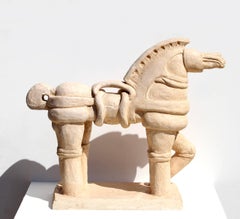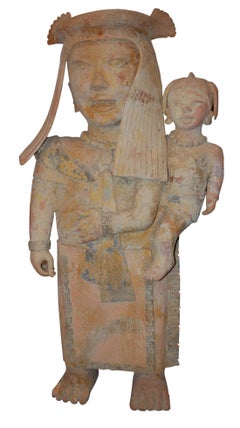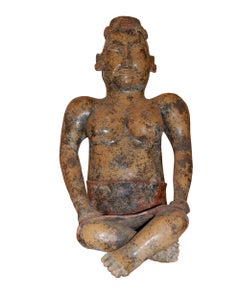Ben A. Gonzales Art
to
1
1
Overall Height
to
Overall Width
to
1
1
1
1
1
1
1
1
1
6,886
3,209
2,514
1,217
1
1
Artist: Ben A. Gonzales
Horse - Taal Mayon, Sculpture by Ben Gonzales
By Ben A. Gonzales
Located in Long Island City, NY
Title: Horse - Taal Mayon
Year: 1981
Medium: Terra Cotta Sculpture, signed and dated
Size: 20.5 in. x 23 in. x 6 in. (52.07 cm x 58.42 cm x 15.24 cm)
Category
1980s Modern Ben A. Gonzales Art
Materials
Terracotta
Related Items
Mother Holding Baby Large Clay Sculpture Pre Columbian Style
By Walter Bastianetto
Located in Delray Beach, FL
Mother Holding Baby, large terra-cotta and clay sculpture.
Modern Pre Columbian style large sculpture edition 1/30, artist signed.
Walter Bastian...
Category
1990s Modern Ben A. Gonzales Art
Materials
Clay, Terracotta
H 43 in W 23 in D 12 in
Seated Figure Clay Sculpture
By Walter Bastianetto
Located in Delray Beach, FL
Seated Figure
Modern Pre Columbian style, large sculpture edition 21/30, artist signed.
Walter Bastianetto is an Italian born sculptor who moved to Mexico in the 1970s and resided ...
Category
1990s Modern Ben A. Gonzales Art
Materials
Terracotta, Clay, Oil
Portrait of Ni-Polog
Located in New York, NY
Signed, dated, and inscribed on the verso:
Malvina Hoffman/ Den Pasar/ “Nipolog”-/ © 1932/ Bali
Provenance:
The artist; her estate.
Literature:
Mal...
Category
1930s Realist Ben A. Gonzales Art
Materials
Terracotta
Continuous Profile of Mussolini "Profilo Continuo
Located in Brookville, NY
Renato Giuseppi Bertellis Born in 1900 in Lastra a sign and died in Florence in 1974. The title is sometimes given as Head of Mussolini, but is better known as Head of Mussolini (Co...
Category
Mid-20th Century Futurist Ben A. Gonzales Art
Materials
Terracotta
H 12 in W 9.25 in D 9.25 in
Roman 18th century terracotta model for the sculpture of San Camillo de Lellis
Located in London, GB
This remarkably fluid terracotta bozetto was made in preparation for Pietro Pacilli’s most important public commission, a large-scale marble statue of San Camillo de Lellis for the nave of St Peter’s Basilica in Rome. Expressively modelled, this terracotta sculpture is a rare and significant work made by a major Roman sculptor at a transformative moment of European sculpture. Pacilli began his working life on the great Baroque decorative projects initiated in the seventeenth century, but he found success as a restorer of ancient sculpture working to finish antiquities for a tourist market, becoming an important figure in the emergence of an archaeologically minded Neoclassicism. Pacilli trained Vincenzo Pacetti and provided important decorative work for the Museo Pio-Clementino, at the same time he is recorded restoring some of the most celebrated antiquities excavated and exported during the period.
Pacilli was born into a family of Roman craftsmen, his father Carlo was a wood carver, and Pacilli is recorded working with him on the Corsini Chapel in San Giovanni Laternao as early as 1735. In 1738 his terracotta model of Joseph and Potiphar’s Wife won the first prize in the second class of the sculpture concorso at the Accademia di San Luca, this is particularly notable as Bartolomeo Cavaceppi came third. He worked as a carver and stuccoist completing works for the churches of San Marco and SS. Trinita dei Domeniciani Spagnoli. Pacilli operated as a sculptor and restorer of antiquities from his studio at the top of the Spanish Steps, close to Santa Trinita dei Monti, where he is listed as a potential vendor to the Museo Pio-Clementino in 1770.
In 1763 Pacilli completed a silver figure of San Venanzio for the treasury of San Venanzio. He is recorded as Pacetti’s first master and it was evidently through Pacilli that he began to acquire his facility as a restorer of ancient sculpture. Pacilli, at his studio ‘poco prima dell’Arco della Regina alla Trinita dei Monti,’ exercised, what the nineteenth-century scholar, Adolf Michaelis called ‘rejuvenating arts’ on several important pieces of classical sculpture, including in 1760 the group of a Satyr with a Flute for the natural brother of George III, General Wallmoden, Hanovarian minister at Vienna. In 1765, Dallaway and Michaelis record that Pacilli was responsible for the restorations, including the addition of a new head, to the Barberini Venus which he had acquired from Gavin Hamilton. The Venus was then sold to Thomas Jenkins, who in turn passed it on to William Weddell at Newby Hall. In 1767 Pacilli exported a series of ancient busts ‘al naturale’ including portraits of Antinous, Julius Ceaser and Marus Aurelius, also a statue of a Muse and a Venus. As early as 1756 Pacilli seems to have been operating as an antiquarian, helping to disperse the collection of the Villa Borrioni. Pacilli supplied sculpture to notable British collectors, including Charles Townley, who on his first trip to Italy purchased the Palazzo Giustiniani statue of Hecate from Pacilli. Pacilli was involved with the Museo Pio Clementino from its conception, supplying busts of Julius Ceaser and a Roman Woman as well as completing stucco putti surmounting the arms of Pope Bendedict XIV to signal the entrance to the new Museo Critiano.
In 1750 Il Diario Ordinario del Chracas announced that Pacilli had begun work on a sculpture of San Camillo de Lellis for St Peter’s. Camillo de Lellis founded his congregation, the Camillians, with their distinctive red felt crosses stitched on black habits in 1591. Having served as a soldier in the Venetian army, Camillo de Lellis became a novitiate of the Capuchin friars, he moved to Rome and established a religious community for the purpose of caring for the sick. In 1586 Pope Sixtus V formerly recognised the Camillians and assigned them to the Church of Santa Maria Maddalena in Rome. Camillo de Lellis died in 1614 and was entombed at Santa Maria Maddalena, he was canonised by Benedict XIV on June 26, 1746. It was an occasion that prompted the Camillians to make a number of significant artistic commissions, including two canvases by Pierre Subleyras showing episodes from San Camillo’s life which they presented to Benedict XIV. In 1750 Pacilli was commissioned to fill one of the large niches on the north wall of the nave with a sculpture of San Camillo.
The present terracotta bozetto presumably had two important functions, to enable Pacilli to work out his ideas for the finished sculpture and at the same time to show his design to the various commissioning bodies. In this case it would have been Cardinal Alessandro Albani and Monsignor Giovan Francesco Olivieri, the ‘economo’ or treasurer of the fabric of St Peter’s. Previously unrecorded, this terracotta relates to a smaller, less finished model which has recently been identified as being Pacilli’s first idea for his statue of San Camillo. Preserved in Palazzo Venezia, in Rome, the terracotta shows San Camillo with his left hand clutching his vestments to his breast; the pose and action more deliberate and contained than the finished sculpture. In producing the present terracotta Pacilli has expanded and energised the figure. San Camillo is shown with his left hand extended, his head turned to the right, apparently in an attempt to look east down the nave of St Peter’s. The model shows Pacilli experimenting with San Camillo’s costume; prominently on his breast is the red cross of his order, whilst a sense of animation is injected into the figure through the billowing cloak which is pulled across the saint’s projecting right leg. The power of the restrained, axial contrapposto of bent right leg and outstretched left arm, is diminished in the final sculpture where a baroque fussiness is introduced to the drapery. What Pacilli’s terracotta demonstrates, is that he conceived the figure of San Camillo very much in line with the immediate tradition of depicting single figures in St Peter’s; the rhetorical gesture of dynamic saint, arm outstretched, book in hand, head pointed upwards was perhaps borrowed from Camillo Rusconi’s 1733 sculpture of St. Ignatius...
Category
18th Century Baroque Ben A. Gonzales Art
Materials
Terracotta
Bust of a Lady, Madame Comtesse Du Barry, Terracotta Bust, French Antique School
Located in Greven, DE
A powerful presentation piece, this stunning bust of Jean Bécu - Comtesse du Barry is both beautiful and tragic. Executed in terracotta that has been left natural and shows a complex...
Category
19th Century Rococo Ben A. Gonzales Art
Materials
Terracotta
Head Of A Warrior Large Clay Sculpture
By Walter Bastianetto
Located in Delray Beach, FL
Head of a warrior.
Modern Pre Columbian style clay, terracotta sculpture artist signed on the right bottom.
Walter Bastianetto is an Italian born sculptor who moved to Mexico in the...
Category
1990s Modern Ben A. Gonzales Art
Materials
Terracotta, Clay
'Coade' Stone Egyptian Lion Outdoor Statue in Classical Style (18th c)
By Coade
Located in Salisbury, GB
Egpytian Lion was produced after we were asked to restore and copy an 18th century 'Coade' Manufactory original at Deepdene House, Surrey, England.
Robert Adam, the 18th century neoclassical architect, ordered these lionesses for Culzean Castle, Scotland, which was the home of Thomas Hope, the designer of the day and arbiter of early 18th century decoration.
The Coade original was modelled on the Egyptian...
Category
2010s Ben A. Gonzales Art
Materials
Stone
H 25.2 in W 48.43 in D 15.36 in
La Testa Terracotta Sculpture by Renato Bertelli
Located in Newport Beach, CA
Midcentury painted terracotta abstract figurative sculpture “La Testa” by Italian Futurist artist Renato Bertelli (1900-1974). Initialized “R. B. A-XI”.
Category
Mid-20th Century Ben A. Gonzales Art
Materials
Terracotta, Paint
Seated Woman With Child Terra-Cotta Sculpture
By Walter Bastianetto
Located in Delray Beach, FL
Seated Mother And Child,
Modern Pre Columbian style large sculpture edition 1/30, artist signed.
Walter Bastianetto is an Italian born sculptor who moved to Mexico in the 1970s an...
Category
1990s Modern Ben A. Gonzales Art
Materials
Clay, Terracotta, Oil
Pio VI blessing on horseback during the Cavalcata for the Possession
Located in Roma, RM
Volpato or Cialli manufacture, molded by Lorenzo Weber, Pio VI blessing on horseback during the Cavalcata for the Possession
English white terracotta of 45 x 29 x 17 cm, datable to...
Category
Mid-18th Century Italian School Ben A. Gonzales Art
Materials
Terracotta
H 17.72 in W 11.42 in D 6.7 in
Head of a Young African Man
Located in New York, NY
Provenance: Private Collection, Spain.
This intriguing and enigmatic sculpture depicts the head of a young African man emerging from a circular opening ...
Category
Early 1800s Ben A. Gonzales Art
Materials
Terracotta
Ben A. Gonzales art for sale on 1stDibs.
Find a wide variety of authentic Ben A. Gonzales art available for sale on 1stDibs. You can also browse by medium to find art by Ben A. Gonzales in ceramic, terracotta and more. Much of the original work by this artist or collective was created during the 1980s and is mostly associated with the modern style. Not every interior allows for large Ben A. Gonzales art, so small editions measuring 23 inches across are available. Customers who are interested in this artist might also find the work of Victor Delfin, Josep Maria Codina Corona, and Walter Bastianetto. Ben A. Gonzales art prices can differ depending upon medium, time period and other attributes. On 1stDibs, the price for these items starts at $7,000 and tops out at $7,000, while the average work can sell for $7,000.
Artists Similar to Ben A. Gonzales
Questions About Ben A. Gonzales Art
- What style of art is Ben Shahn?1 Answer1stDibs ExpertFebruary 7, 2024The style of art of Ben Shahn is social realism. Artists working in this movement sought to highlight social issues by depicting scenes that showed the struggles of modern-day life. For example, Shahn produced four paintings and more than 100 drawings inspired by a 1947 mining accident that killed 111 people in Centralia, Illinois. Arguably the most famous of these works is Miner's Wives, which shows the widows of the miners in mourning. On 1stDibs, shop a variety of Ben Shahn art.


